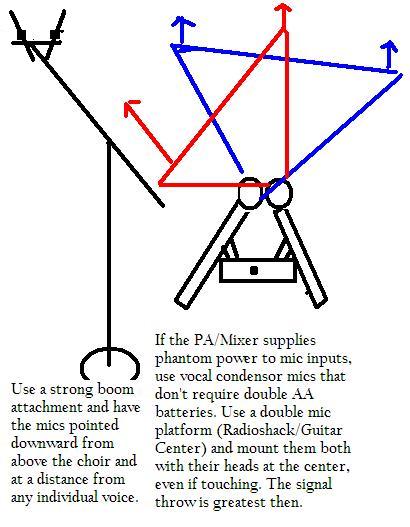setting up mics for a 5-6 person choir
-
Hi Everyone,
I am looking for some help on trying to set up mics for a regular choir. As much as I like to idea of hanging mics, the church has no money for them. In place of hanging mics, we have two omni-directional (?) mics. What I have been doing in the past is having the two mics set up so two voices share one mic. Since there are only sometimes 4 as many as 5 or 6 voices, I've never had an issue with this set up. They would all just huddle around a mic and it never sounded bad. One of the choir members that has sang her whole life in the choir recently was taken ill and could potentially not be singing again. The woman that has taken her place is not a choral blending singer. She is a soloist voice and blending is not a easy thing/often overpowers the other voices (even when I have her mic set to 3 on the volume and the other mics are set to 4 1/2, 5 and sometimes 5 1/2. Since there are so few singers in the choir already, I am not going to ask her to not sing with them. How do I get a better blend between the voices and I think the answer is found in how the mics need to be set up?
What my new idea is to have the choir stand where they normally do but I put the mics on the floor. The choir stands on the first large step and the mics are placed over the heads instead of directly in front of their mouths. I do understand this is very hard to picture..... but I'm looking for some help. I think by having the mics set up this way, I can get a level balance of putting both mics around 3 or 3 1/2 on the mixer and get a blended sound. Does that sound correct?? I need some sound tech guys advice!
Any advice would be greatly appreciated! :-)
If you need me to clarify anything please ask and I will do my best (even though I'm not a sound guy by any means!) -
You need to fix the choir not rearrange the microphones.
You have to get her to sing in a way that blends with the other singers. You can use her confidence and abilities to help encourage the others to sing out, which they are not doing....at the same time she has to control her voice to blend and not overpower them.
You've got to take control. You need her in this situation. You can use her to improve things
The worst choirs are ones that cannot do anything but sing loud....or soft. If you work with her the problems that you are experiencing can be turned around to improve the entire choir.
You need her to be asking you if she is singing too loud and the others asking you if they are singing loud enough. Praising her for her abilities will help encourage her to work with you and influence the choir in a positive manner.
If the choir needs amplified - which in some churches is absolutely necessary - one microphone in the center should be enough...all people standing an equal distance from it. Get one microphone up high, just like you are planning and arrange the people in a half circle around it...they need to sing to each other, not the room, otherwise there can be no blend.
Individual microphones for each singer or two singers put through a mixer gives you the sound of these voices. If you want choral sound you need to amplify the blended voices of the choir or a microphone, not blend them in a mixer.
I hope that this is encouraging and not putting you and your situation down. You've got the drive and dream of a good choir, you can achieve this with 4 to 6 singers. The blended sound of singers is one of the few things that are true synergy. This problem can be turned into a promising situation.
By the way, if she will not try to blend, get rid of her. It's that simple!Thanked by 1IanW -
I totally agree with Frogman. I have 12 people in my choir and 5 mics. Singers are always scrambling for them. For our Christmas cantata, I also used the children's choir and they used all the mics. The sound was never better. The choir finally blended when nobody was competing for amplification and they all actually listened to each other. The children needed the mics, but it worked great. It's easier to train children than to try and train diva singers into NOT using mics. As far as one singer not blending, I also agree with Frogman on that point. Speak to her lovingly and explain blend. If she cannot abide by your suggestions and support, then gently tell her she is not in ministry and needs to re-think her participation. I also had the same situation with a male singer. He simply cannot sing. I've tried to get him to blend, given him free private lessons and made endless tapes. He didn't use any of the help to do better. For Christmas I simply put him in the back row, and told him NOT to sing on several hymns. It humbled him enough to sing and blend today.
It's so hard to be in ministry to singers who are divas and refuse to listen to simple direction, but the Lord put us all in these positions for a reason. I have yet to figure that out yet, but as long as He wants me there, I will do His work, and sometimes, that means losing friends and finding myself in difficult situations.
God bless and good luck. Happy, blessed New Year.
Thanked by 1IanW -
What strikes you as sarcastic?
-
Didn't know if you were trying to poke fun at anything with the level of detail/color in the diagram.
I've also never seen that setup before ... and don't know enough about mic placement to think anything of the "even if touching" phrase at the end.
Is this actually an effective way to place mics?
(Honest question, sorry if it came off as rude)
Also, would it work with omni-directional mics, or would that cause feedback? -
Is. Works. M, do you run board in stereo or just mix for mono? Bet it works nicely for live work.
I use ORTF for choral/organ recording but with omnis plus a third piezo ambiance microphone about 30' back. Thanked by 1bJoseph
Thanked by 1bJoseph -
Ditto. There is a difference between mic placement for live sound reinforcement and recording. If your live PA system is mono (most are) there is really no point in running stereo mics.
And if you are going to place two mics close together as in the diagrams above they need to be a matched stereo pair otherwise you will get phase cancellation (this also happens when the priest or deacon forgets to turn off his wireless and walks up the ambo!).
Also check to see if the mics you are using are actually omni directional. Unless you want to mic the entire room for an ambient recording it's probably not a good idea for live sound unless you are going to suspend them up high. You could use a spaced stereo pair for a larger choir, but for a small group of singers one decent condenser mic placed in the center of the group (and far enough away to pick up the blended sound and not individual voices) should do the trick...
Also ditto on the blending. That needs to happen before the sound hits the mic. The only time you want to give everyone their own mic and mix it through a sound board is when you are performing in a praise band--but that's not choral singing. On a personal note, I was trained as an opera singer. It is possible to blend in a choir if you really know how to use your instrument. -
It is possible to blend in a choir if you really know how to use your instrument.
Indeed it is!Thanked by 1M. Jackson Osborn -
Amplifying choirs (or any singers) is not a reasonable option for authentic liturgy.
-
However, in some buildings, it's a necessity if the choir is to be heard by anyone other than God and the MD.
-
Well trained choirs who have been taught how to project sound are capable of adapting to any acoustical environment.
Plus: it's cheaper to get rid of carpeting and pew cushions (I've even seen [only in Catholic churches] padded walls). Get rid of these and an expensive PA system is not even needed... provided speakers and singers know how to project their beautiful voices with learned oratorical skills instead of having their sound warped and canned by microphones and speakers.Thanked by 1E_A_Fulhorst -
However, if you have sound-dampening tile on the ceiling, and the previous people built a new choir area around the corner in the transept, and there is no chance for remodel...then even with awesome singers, still, no one will hear you. They already paid for the expensive system a couple years before I came...so while not ideal, renovating is not an option.
I am finding the mic placement advice very helpful, since I have to use what I've got.
-
It's cheaper to get rid of a demanding DM who insists that carpet and pew cushions be removed.
"Will no one rid me of this turbulent director of music?" is a cry often heard in rectories.
There are way too many semi-circular RC churches that defy the elimination of amplification. Since these buildings are not designed to focus vision and sound, but instead to give everyone a better view, only amplification has a chance of letting them all hear...unless you put the cantor and the priest and the choir on spinning platforms going around and around very fast so that everyone would get direct sound a couple of times a second...the doppler effect alone would be entertaining.
Melofluent's mic layout would eliminate phasing problems for live performance, which is why it is effective - strange looking, but would work very nicely.
Ally, every so often, have the choir sing softly standing in the back of church - this works really well at communion or before mass - at communion they can sing and then you stop them and they may go up and receive. It's a gentle way to let people hear what the music could be like if the choir were in a better location.
Amplification is very effective only when it is set so that it is hard to figure out if it is on or not...the moment the level rises above that, it fails. It helps, if you have to have a sound person twiddling knobs, for it to be a woman. Men, as well all know, tend to want things louder. [no teenagers, for the same reason]. -
FNJ, we're "old school" to a fault, no stereo, no slider level mixers, one main, two 8-channel dialed Shure mixers, feedback suppression, power switch on, power switch off.
Thanks for the backup.
@ryand- one new year's resolution that will be more difficult for me than losing half my body weight will be to stop having or poking fun on internet boards. -
mjo
i would like to buy some padded walls just for my office, please -
This issue reminds me of the cathedral in my diocese. Its sanctuary was rearranged in the 1980s so that it would look attractive on TV at the time, since the diocese ran its own local cable channel (which is now available in other cities and called "CatholicTV").
The front pews were removed and a broad open space was covered with carpet. An organ console was installed at the front-right and a place was erected for the choir there. BIg ugly platforms for cameras and other equipment were installed. That's the situation.
Without amplification, the choir and the cantor wouldn't be heard beyond the first row on the right side.
And -- as it happens -- that section is set aside during special events for the deaf community and the ASL interpreter! So nobody would hear the choir! :-)Thanked by 1bJoseph -
Missa di Doppler would be entertaining.
Welcome to the MusicaSacra Forum!
To participate in the discussions on Catholic church music, sign in or register as a forum member, The forum is a project of the Church Music Association of America.
Categories
- All Discussions21,106
- General Music Discussion7,594
- Job Openings1,303
- Management of Music Programs833
- Choral Matters519
- Church Documents and Rubrics504
- CMAA Notes291
- Events651
- For Newcomers: Read First23
- Sacred Polyphony528
- Hymnody821
- Gregorian Chant: General2,582
- ↳ Graduale Romanum and Liber Usualis354
- ↳ Graduale Simplex55
- ↳ Semiology57
- Vernacular Plainsong671
- Anglican Use and Anglican Chant66
- Organ, Other Instruments and Repertoire414
- New Composition/Works in Progress1,208
- Recordings222
- Music for Hispanic Ministry151
- Music Education: Children205
- Music Education: General214
- News Items242
- Positions Wanted58
- General Discussion: Catholicism723
- Amusements170
- General Discussion1,000
- Opinions113











